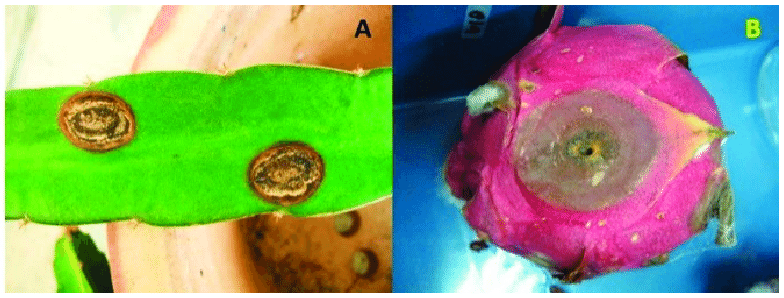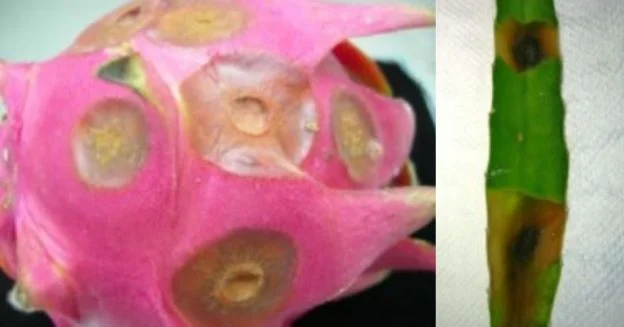Anthracnose is a common fungal disease affecting many plants, including dragon fruit (pitaya). Colletotrichum is a genus of fungi that includes several species responsible for causing anthracnose in various crops. These fungi are known for causing fruit rot and other symptoms, leading to economic losses in agriculture.

What is anthracnose?
Anthracnose, a term derived from the Greek words “anthrax” (coal) and “nose” (disease), encapsulates the essence of a fungal infection that frequently plagues a myriad of plants, including the exotic dragon fruit. Within this expansive realm of fungal villains, the Colletotrichum genus takes centre stage as the orchestrator of dragon fruit’s descent into a state of morbidity.
Symptoms of Colletotrichum anthracnose in dragon fruit may include:
- Lesions and Spots: Small, dark lesions or spots may appear on the dragon fruit’s skin, often water-soaked.
- Fruit Rot: The fungus can lead to the decay of the fruit, making it unsuitable for consumption. The rotting process may start in the infected areas and spread throughout the fruit.
- Sunken Lesions: Infected areas may become sunken and may have a dark border, giving them a characteristic appearance.
- Spore Production: In advanced stages, the fungus may produce spore structures, such as acervuli or conidiomata, which can be visible on the surface of the lesions.
- Leaf and Stem Lesions: Anthracnose can also affect other parts of the dragon fruit plant, including leaves and stems, causing lesions and potentially leading to defoliation.

Control Measures: Orchestrating Anthracnose Defences
1. Cultural Practices: The Foundation of Defence
In the battle against anthracnose, cultural practices form the bedrock of defence. The mantra here is sanitation, a rigorous commitment to the removal and destruction of infected plant material. This is akin to purging the battlefield of fallen comrades to prevent the enemy from regrouping.
Proper spacing between dragon fruit plants becomes a strategic move, fostering air circulation that acts as a natural deterrent to fungal propagation. Cultivation involves a delicate dance, and avoiding overhead irrigation is a key step in preventing moisture from settling on plant surfaces and creating an environment conducive to anthracnose.
Regular pruning is akin to strategic planning in warfare. It’s a calculated move to enhance ventilation within the plant canopy, minimising the risk of fungal infiltration. In this choreography of cultivation, every action contributes to the resilience of the dragon fruit orchard.
2. Biological Control: Nature’s Allies
Harnessing the power of nature’s allies, biological control introduces beneficial microorganisms into the battleground. These microscopic soldiers engage in a silent war, competing with the Colletotrichum fungi or outright antagonising them.
It’s a sophisticated strategy where the dragon fruit cultivator allies with nature’s unseen forces to tip the scales in favour of harmonious coexistence, preventing the undue dominance of the fungal adversary.
3. Chemical Control: Fungicidal Arsenal
When diplomacy falters, chemical control steps onto the stage. Fungicides become the arsenal of choice, a calculated response to either prevent the onset of anthracnose or curb its progression. However, the wise tactician understands the importance of variety; a rotation of different fungicides is essential to thwart the development of resistance within the fungal ranks.
In the grand strategy of anthracnose management, fungicides play a dual role: a shield for the uninfected and a sword against the advancing fungal forces. Careful deployment is crucial to maintaining the delicate balance between protection and potential harm.
4. Resistant Varieties: Fortifying the Frontlines
In the evolution of dragon fruit cultivars, the concept of resistance takes precedence. Planting dragon fruit varieties that showcase resilience against Colletotrichum anthracnose is akin to fortifying the frontlines. It’s a preemptive strike, a proactive measure to prevent the infiltration of the fungal adversary.
The cultivation landscape evolves, and the dragon fruit orchards of tomorrow stand as bastions of resistance, impervious to the insidious whispers of Anthracnose.
In the relentless war against Anthracnose, the role of vigilance stands paramount—a vigilant sentinel guarding the dragon fruit orchard against the relentless onslaught of the Colletotrichum fungus.
5. Environmental Considerations:
Environmental factors exert profound influence on Anthracnose dynamics. Humidity and temperature fluctuations serve as catalysts for disease progression, warranting meticulous attention to microclimatic conditions. Implementing shading mechanisms and optimizing irrigation practices mitigate environmental stressors, bolstering dragon fruit resilience against Colletotrichum onslaught.
6. Integrated Pest Management:
The ethos of integrated pest management (IPM) resonates deeply in the quest to conquer Anthracnose. By harmonizing cultural, biological, and chemical management tactics, IPM cultivates a synergistic approach to disease control. Strategic monitoring, coupled with timely interventions, embodies the essence of proactive stewardship in orchard management.

The Watchtower of Vigilance
Imagine the dragon fruit orchard as a fortress, its defences reliant on the watchful eyes of vigilant caretakers. Regular monitoring becomes the watchtower, an elevated vantage point from which every subtle movement in the landscape below is scrutinised.
Humidity and Rainfall: The Breeding Grounds
The Colletotrichum fungus prefers periods of increased humidity and rainfall, so vigilance increases during these times. These become the breeding grounds for the insidious anthracnose, and the vigilant sentinel recognises the vulnerability that accompanies these environmental cues.
Early Detection: Intelligence Gathering
Early detection, akin to gathering intelligence on the enemy’s movements, provides a crucial advantage. The sentinel, armed with knowledge, patrols the orchard, scrutinising every inch for signs of the fungal adversary. Small, dark lesions on the fruit’s surface become the coded messages, deciphered by the vigilant eye.

Strategic Countermeasures
Armed with insights gained from vigilant monitoring, strategic countermeasures come into play. The vigilant caretaker, much like a skilled tactician, formulates a response before the situation escalates. It’s a proactive stance, a calculated move to thwart the advances of Anthracnose before it gains a foothold.
Interventions and Treatments
Vigilance directs the timely application of interventions and treatments. Whether it’s the deployment of biological control agents or the strategic use of fungicides, the vigilant caretaker ensures that the response is swift and targeted. The aim is not just to suppress Anthracnose but to outmanoeuvre it, disrupting its insidious plans.
The Collaborative Effort
Vigilance extends beyond individual efforts; it’s a collaborative endeavour. Orchards thrive when caretakers share insights and experiences, forming a network of vigilant sentinels across the agricultural landscape. Local agricultural extension services become hubs of information exchange, enriching the collective knowledge pool.
Adaptive Strategies
In the ever-evolving battle against anthracnose, vigilance necessitates adaptive strategies. The vigilant sentinel remains attuned to emerging research, novel technologies, and evolving best practices. It’s an ongoing commitment to staying ahead of the fungal adversary’s tactics.
Conclusion
In the intricate tapestry of dragon fruit cultivation, the specter of Anthracnose looms as a formidable adversary. By unraveling the intricacies of symptoms and embracing proactive management strategies, orchardists arm themselves against the perils of Colletotrichum. The journey towards resilience demands unwavering dedication, tempered with a steadfast commitment to the orchard’s vitality. Through collective wisdom and shared knowledge, the orchard thrives amidst the ebb and flow of nature’s dance, resilient in the face of adversity.
you can read: all diseases of dragon fruit plant
